Executive Summary
The sales industry is a dynamic environment that is extremely sensitive to external and internal fluctuations. As a result of technological pressure, the sales industry has discovered a new branch of evolution called online shopping. Today, some 2.14 billion people worldwide are digital shoppers, which means they shop online. Unlike retail stores, e-commerce offers enhanced opportunities for content personalization and loyalty systems, which is encouraging more and more consumers to go online. In turn, this affects the evolution of online shopping as a change-sensitive system. The article assesses the main factors influencing online shopping practices and examines these patterns in the context of international business. A thorough parallel study of the academic and public literature has demonstrated the multiplicity of such factors. In addition, the paper assessed the potentially disruptive effects of online shopping on retailing.
Introduction
Background
Business management practices are changing rapidly in today’s globalized world. Using conservative techniques to multiply profits would be misguided for current businesses as structural transformations of the consumer sector have occurred (Dillaha, 2021). Thus, today’s businesses cannot exist efficiently and quickly without the use of digital and cloud technologies that significantly optimize data management practices (Đorđević, Radović, and Bonić, 2018; Muthoni, Chemwa, and Okeyo, 2020). Business computerization is occurring in different directions, but each of the practices being implemented aims to automate operational processes and ultimately maximize profits; this is only natural in a dynamically changing entrepreneurial industry. However, profound digitalization and related factors have not only affected the physical part of technological business transformations but have also influenced changes in shopping patterns as such. Consumers who are willing to spend money have been given the opportunity to shop from the comfort of their homes using Internet technology. This has led to the emergence of online shopping as a new evolution of the consumer sector.
The current digital transformation of the business sector, in which every individual with a computer or smartphone can buy any product he wants online from virtually any country, is leading to a structural change in entrepreneurship. Inspired by making big money, businesspeople are rapidly investing in the development of online shopping platforms (Lindzon, 2021). In turn, such moves lead to a saturation of the consumer market with private and small online stores combined with giant aggregators like Amazon, eBay, AliExpress, and other online venues (Burke, 2021; Mahmud, 2021). The observed evolution of shopping practices leads to speculation about how consumer shopping will subsequently change and whether this will become a problem for physical stores. It is these doubts, reinforced by concerns about the financial well-being of offline stores, that create the need for a qualitative analytical study of the evolutionary patterns of online shopping.
Meanwhile, the consumer sector of online shopping continues to evolve and offer shoppers more technical options for a more comfortable shopping experience. While the essential core of shopping remains unchanged — consumers still spend their hard-earned money to get a product or service in return — the organizational practices of these processes are significantly transformed. Even after paying for a product, the customer usually does not receive it immediately as he or she is waiting for courier delivery. Depending on remoteness, urgency, and category of the purchased goods, delivery can take from several minutes to several months. As a consequence, the average online shopper has already developed specific patterns of waiting for a particular category of product, beyond which customer dissatisfaction can result (Berthiaume, 2020). Thus, there are many different factors that influence the evolution of online shopping patterns. Some of them seem more understandable, while others may not be obvious at first glance and thus require closer observation.
From this perspective, the topic of the current research paper — the study of online shopping patterns and their significance for international business — turns out to be highly relevant for both public and academic circles. In terms of societal relevance, the ongoing research responds to the need for a cross-sectional study of current trends and a longitudinal study of the possibilities of the online shopping sector with assumptions about future changes. The research makes a unique contribution to understanding the problem of online shopping as a phenomenon that did not just emerge but instead became a natural extension of the digital, political, and, importantly, cultural transformations in the world. In terms of academic relevance, the present study proves helpful in exploring potential links between the psychosocial patterns of society and the decision to buy goods. This should shed light on the lack of knowledge on the evolution of the consumer sector and the potential for its development.
Meanwhile, the present research paper has several positive implications for stakeholders. First, it uncovers patterns of connection between influence factors and online shopping dynamics. Second, these patterns can be used to refine companies’ marketing strategies. Third, a systematic review summarizes available but disparate data, bringing it together to create a conceptual map. Finally, the work can be used by the following authors as a cross-sectional reference that reflects current data for 2022.
Research Questions and Objectives
- What are the factors that have influenced the evolution of online purchasing models?
- How have today’s online purchasing models influenced international businesses and the strategies they implement?
- Can online platforms satisfy the entire market?
As can be seen, the research questions of this paper are broad and wide-ranging and thus require a thorough analysis of available data and sources. In order to systematize the methodological approach for more reliable research, the overall goal of the whole work was divided into separate tasks, the solution of which is a priority. Thus, the following research tasks are necessary:
- Conduct a thorough literature review and identify the main patterns available in the sources;
- Build a conceptual map to identify patterns in relation to online shopping.
- Evaluate the available data in light of a comparative study.
- Provide recommendations for future directions of the project.
Literary Review
Academic Relevance of the Problem
The primary objective of the literature review was to attempt to determine the extent to which the issue of online shopping is relevant in academia. At first glance, this topic may not seem to be widely studied among the academic community due to its everyday simplicity, but a deeper analysis reveals that online shopping as a research topic has considerable interest. Reference to Figure 1 shows an exponential increase in the number of thematic publications and their citations in relevant sources. From this Figure, one can conclude that the topic of “online shopping” has a high research interest, especially since 1998, when some of the first papers were published. Interestingly, more than half of the published papers have been published in the last five years alone. This growth does not seem surprising, given that the intensification of online shopping is coupled with the development of Internet technology and the increasing accessibility of communities to digitalization (Boustani, 2021; Fuentes, Balkow, and Wittrock, 2021). Meanwhile, it would be a mistake to think that “online shopping” is studied strictly in the economic and social sciences. In this sense, it is appropriate to turn to the visualization in Figure 2 to see that scholarly publications and abstracts on this topic are produced in such categories of academic fields as “management,” “computer science,” and “artificial intelligence.” However, while such areas may seem obvious, exploring aspects of online shopping in the fields of environmental science and green sustainability and educational disciplines, as seen in Figure 2, may be surprising. Based on the above, the topic of online shopping has a heightened research interest among the scholarly community and is being studied by them from a variety of angles.
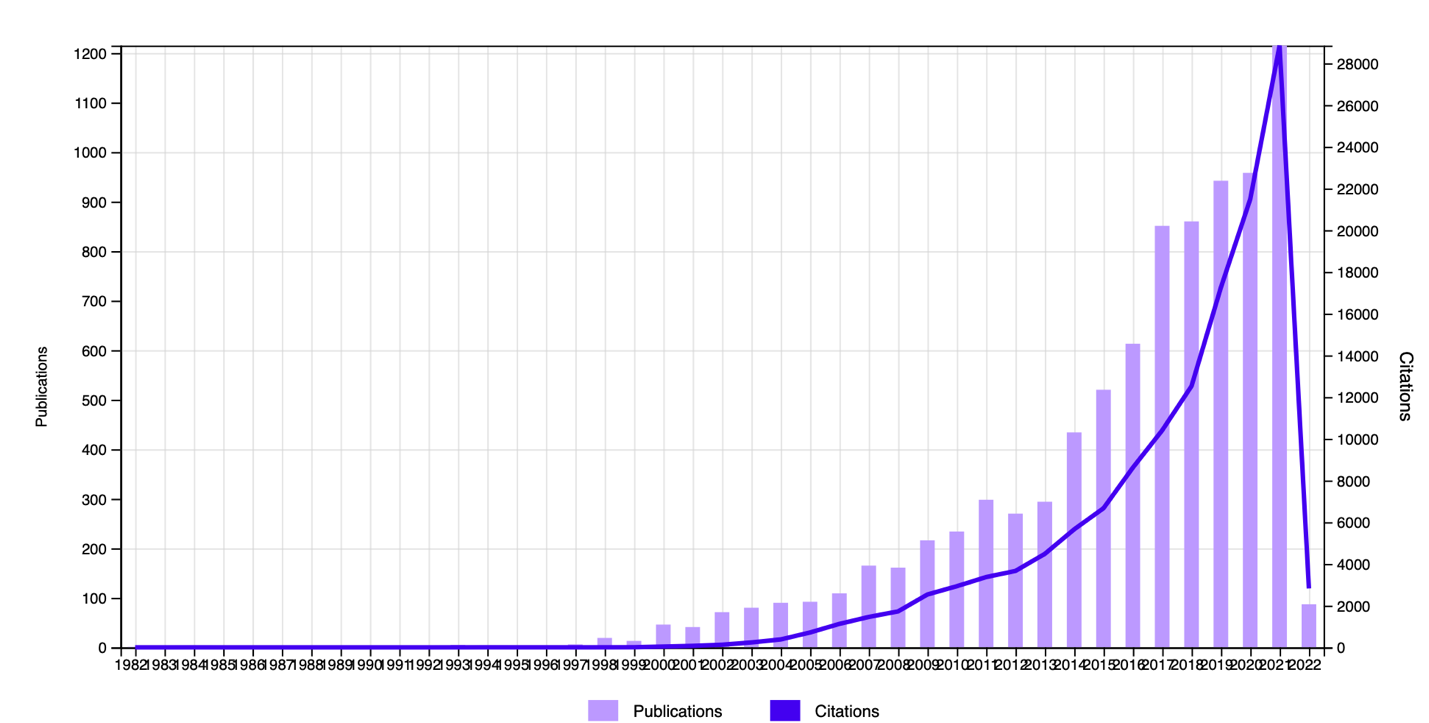
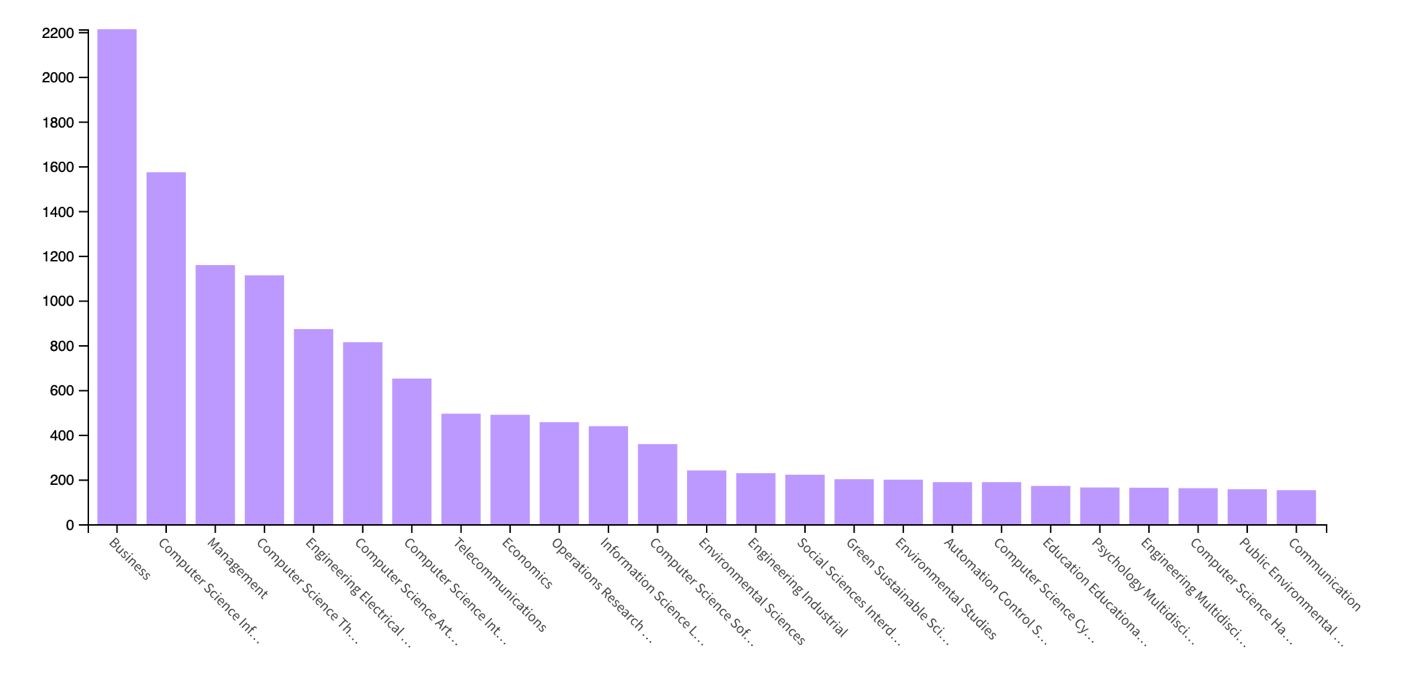
The Importance of Online Shopping
When examining the patterns that lead consumers to make online purchases, one should consider the significance of the procedure as such. First of all, it should be clarified that by 2021, approximately one in four people in the world is shopping online (Coppola, 2021). According to Kaur and Kochar, “online shopping is a form of electronic commerce which allows consumers to directly buy goods or services from a seller over the Internet using a web browser” (Kaur and Kochar, 2018, p. 54). In this definition, one can see that direct interaction between the consumer and the seller is an essential feature of online shopping. In fact, it is one of the main differences between this sales approach and physical stores, which are often intermediaries between different parties (Peacock, 2021; Wu, 2021). The presence of such an intermediary can make shopping more accessible because the individual gets to examine the physical appearance and assess quality before buying, but the price for such an intermediary is the added cost of the product, which is superimposed on the manufacturer’s selling price; in other words, the customer must pay more for the increased comfort of shopping (Maheshwari, 2020). It is significant to emphasize that shopping (whether offline or online) in general is not aimed at satisfying a single need of individuals but instead covers different needs depending on the type of shopping, the mood of the individual, and a number of secondary factors. For example, shopping primarily serves a utilitarian function, allowing customers to purchase basic necessities essential for efficient living (Yu, Zhang, and Liu, 2018; Scarpi, 2021). These typically include food, water, clothing and medicine, fuel, and work or educational supplies: in other words, all products and goods without which society’s everyday life cannot be functional. An interesting perspective on online shopping is expressed by Nasidi et al., who show that “online shopping is relaxation for individuals engaged in a busy life” (Nasidi et al., 2021, p. 386). Looking at online shopping from this perspective, it is true that online shopping can be a leisure time activity. Working and busy people rarely find free time to visit shopping malls, but ordering necessary goods online helps to save much time.
This argument becomes especially significant when discussing online shopping for groceries, or utilitarian items, specifically home delivery of groceries. For example, individuals may not find the time or desire to visit supermarkets after work hours to buy groceries for dinner, so online grocery shopping with grocery delivery services significantly solves this problem (Redman, 2021; NCR, 2021). Among other things, it is not uncommon for such web-based applications to offer loyalty systems and discounts to the customer, which further incentivize them not to visit the actual stores. A critical angle on the problem of online shopping is raised by a researcher from Pakistan who states that this shopping option is motivated by the hedonistic desire of individuals to escape from themselves (Mir, 2021). The escapism described is expressed in a desire to escape the need for personal and professional development through online shopping opportunities that raise issues of secondary importance related to appearance and social status (McLean, Al-Nabhani, and Marriott, 2022). Nor can one deny the hedonic functions of shopping, which allow individuals to receive emotional feedback from the actions they take. This applies not only to the procedures of selecting a particular item and consequently the cognitive embedding of that item in the consumer’s life, but also to receive the emotions of receiving an order and interacting with it over time (Platania, Santisi, and Morando, 2019; Katharine, 2020). Consequently, it would be accurate to say that one of the reasons why people shop is the need for emotional satisfaction. The escapism of online shopping is expressed in the escape from their problems and search for solutions for them in the direction of more accessible, entertaining leisure activities.
The above cannot help but resemble the well-known model of motivation theory called Maslow’s hierarchy of needs model. The pyramid of sequential is shown in Figure 3: the principle is based on a sequence of filling levels of needs so that the individual can have the needs of the higher levels covered when, the lower ones are closed. The uncovered sense of belonging to social groups, expressed at the third level, leads to the impossibility of moving to the higher mental needs of the individual (Noltemeyer et al., 2021). This same pattern is also emphasized in McKinsey’s annual report, which indicates that leads among online purchases are characteristic of the Millennial and high-income generation (Charm et al., 2020). This pattern can be used intelligently by marketers to boost company sales.
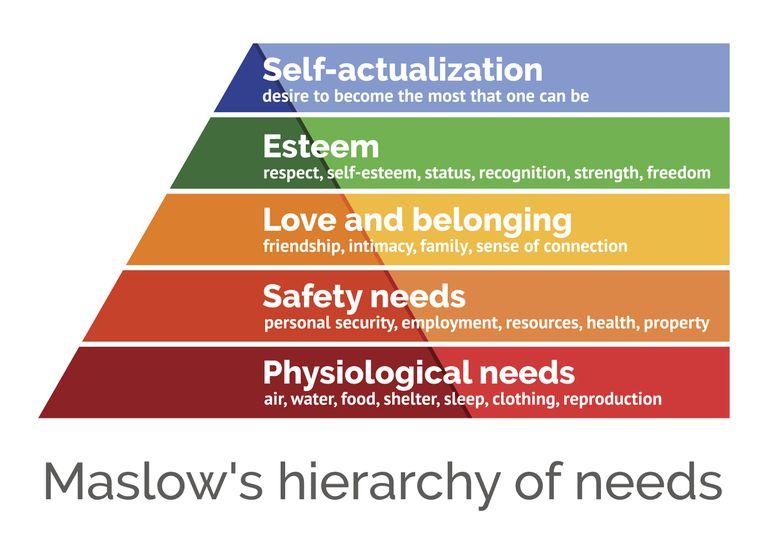
Trust as a Motivating Factor
Motivating consumers to shop online is a crucial question, the answer to which is of applied value to both research and entrepreneurs interested in maximizing profits. However, it would be misleading to indicate that there is a single, universal rule that compels individuals to make an online purchase (Prajapati, 2021). On the contrary, the diversity of the world with the intensification of globalization processes is the reason there is no such universality (Boghian, 2018). Specific motivational factors depend on a plethora of independent data to set the agenda for each specific community. Nevertheless, some generalizations can still be found with a careful examination of the literature.
Among the most common themes highlighted by research authors is trust as a factor motivating online purchases. According to the Merriam-Webster Dictionary, trust should be understood as sufficient belief in the reliability and honesty of someone or something (Trust, 2022). In relation to online shopping, trust is defined by consumers’ belief that the platform will honestly work out the money received and fulfill all promised requirements, including product quality and delivery times. Researchers often measure trust as a quantitative measure to conduct correlational or regression tests (van Rooyen and Amoah, 2021). The results of one such test showed that the higher the level of trust customers have in an online platform, the more often they make online purchases (Alharthey, 2020). Online shopping involves the disclosure of personal information, including contact information and residential address, to third-party companies; credit card numbers are also reported. In this sense, a high level of trust determines consumers’ perceived reliability in protecting their data from unauthorized use: when filling out online credit card forms, customers need to be confident in the transparency of their processing (Nguyen and Khoa, 2019). Some of the authors explore the phenomenology of consumer trust at a deeper level, obtaining intriguing results. For example, Nghia, Olsen, and Trang (2020) showed that affective levels of trust are positively related to intentions to make online purchases, whereas cognitive trust shows no such relationship. It is pertinent to clarify that affective trust refers to a fervent belief in the reliability of online shopping, which is based on personal feelings (Chen et al., 2021). In contrast, with cognitive trust, the perception of reliability is based on a rational view of the online store built on knowledge and available information.
Emotional Attachment as a Motivating Factor
Emotional attachment is also often emphasized by authors of scientific studies as one of the motivating factors for shopping. The quantitative experiment by Makkonen et al. (2019) found that both positive and negative emotions are experienced during online shopping, but the constructive effect on repeat purchase intentions of positive emotions is more substantial. The same authors also built a model, reflected in Figure 4, showing the effects of different levels of emotions on aspects of online shopping, namely repeat purchases and word-of-mouth type recommendations. In this pattern, it was found that the association of positive emotions with patterns was much more significant and stronger than negative emotions. Another study on a similar topic found that the core of negative emotions when interacting with online stores is formed by the unpleasant interface of the platform, perceptions of low reliability, and high prices (Kemppainen, Makkonen, and Frank, 2019). In other words, negative emotions are more likely to lead to a refusal to make an online purchase than positive ones.
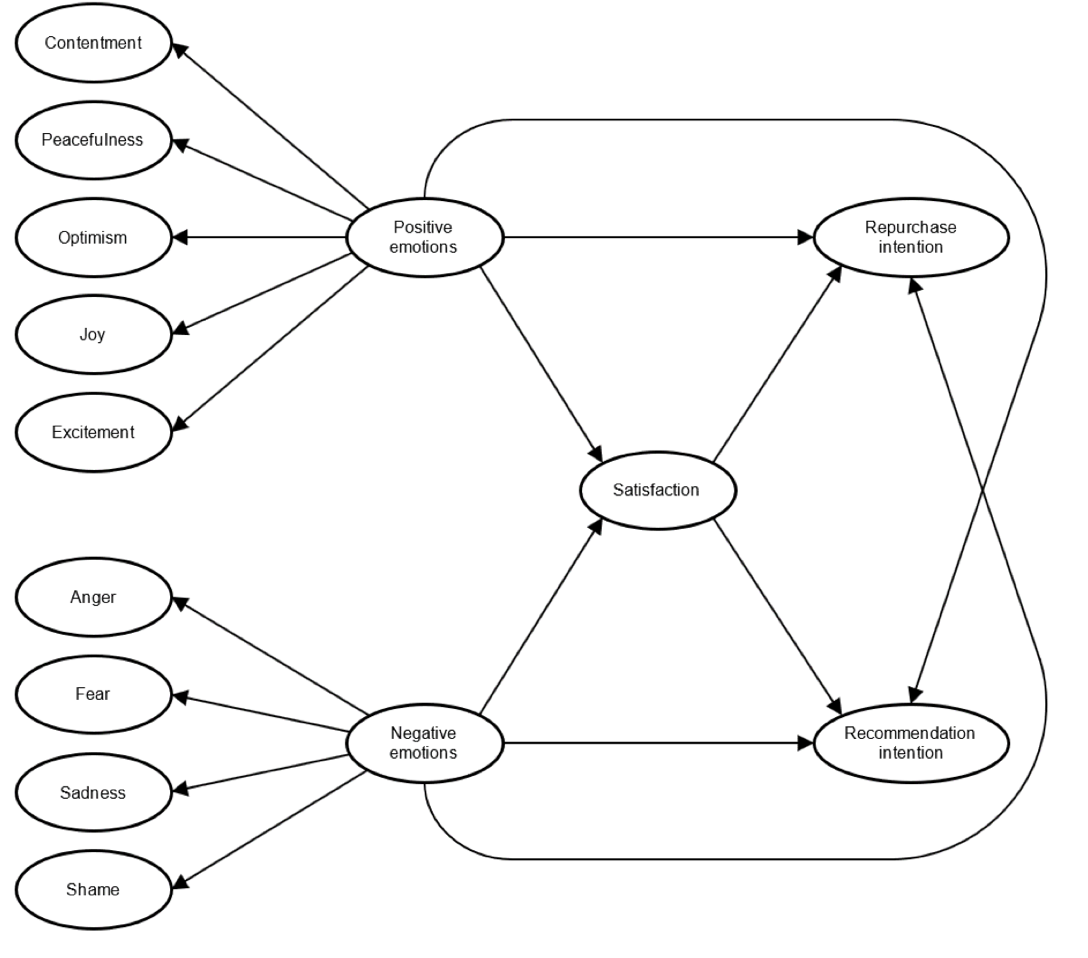
Satisfaction System as a Motivating Factor
Both trust and emotional attachments, in turn, are part of the consumer satisfaction system. The authors point out that “consumer satisfaction is one of the important factors to be discussed in the process of online shopping” (Lin et al., 2020, p. 197). However, such satisfaction is not permanent, which means that a customer satisfied with an online platform today may be disappointed in it tomorrow if he sees its shortcomings as critical. Determining the depth of customer satisfaction is part and parcel of scientific research; thus, perceptions of availability, safety, price, time spent, quality, and delivery time have been determined to be critical components of customer satisfaction (Vasić, Kilibarda, and Kaurin, 2019). Meanwhile, the need to return goods due to inadequate quality reduces customer satisfaction, although good post-sales service can minimize risks (Tzeng et al., 2021). Consequently, consumer satisfaction with online shopping experiences and merchandise is an essential feature of changing e-commerce models.
Closely related to consumer emotions are the marketing campaigns used by online platforms. The use of targeted advertising, content personalization, and digitalization of marketing campaigns are closely related to the increased commercial effectiveness of online platforms compared to offline stores (Lybbert et al., 2018: Tahaei, Frik, and Vaniea, 2021; Buyruk and Güner, 2021; McKinsey, 2021). Although personalization can help the customer choose the product they want and improve responsiveness, research shows that not all consumers tend to view shopping personalization positively (Hassan, 2021). In the context of increased privacy concerns and significant scandals involving leaks of sensitive customer data by large companies such as Facebook, such concerns do not seem surprising (Lu et al., 2020; Bowman, 2021; InfoWatch, 2018). Meanwhile, online marketers use emotional contrast to increase sales. Lee J. and Lee Y. found that the aesthetic component of shopping, that is, the use of engaging media content and patterns, positively influences the size of a customer’s shopping cart (Lee J. and Lee Y., 2019). Consequently, it creates a need for online platforms to invest in increasing the overall appeal of the store in an effort to earn more profits.
Lockdown as a Motivating Factor
The impact of external factors on the consumer sector that is beyond governmental control should also be considered. In particular, the COVID-19 pandemic has led to a significant change in the structure of life, moving many of its aspects into the digital realm (Velavan and Meyer, 2020; Kitayama, Camp, and Salvador, 2022; Lenton, Boulton, and Scheffer, 2022). Internet technology has modified educational and work practices in recent years, and even medicine has taken a new direction in the form of telemedicine. The use of digital technology during the pandemic has grown significantly: statistics show that the Internet was important to 90% of users, with about 40% of individuals beginning to use Internet technology in new ways (Mcclain et al., 2021). Online shopping should be among these changes, as quarantine measures have forced large numbers of people to stay at home. Home tablet sales have been shown to increase by 17% year over year because of COVID-19 (Chang, 2020). As a consequence, individuals forced to spend time on their own within the walls of the home have turned more often to online platforms to purchase goods, especially when malls are forced to close. This is perfectly demonstrated by examining the dynamics of the e-commerce market in the first half of the quarantined year. A reference to Figure 5 makes it clear that COVID-19 first dramatically lowered the volume of this market and then rapidly raised it to record levels within six months. In other words, people became more likely to shop online because their shopping needs could not be met by the health agenda.
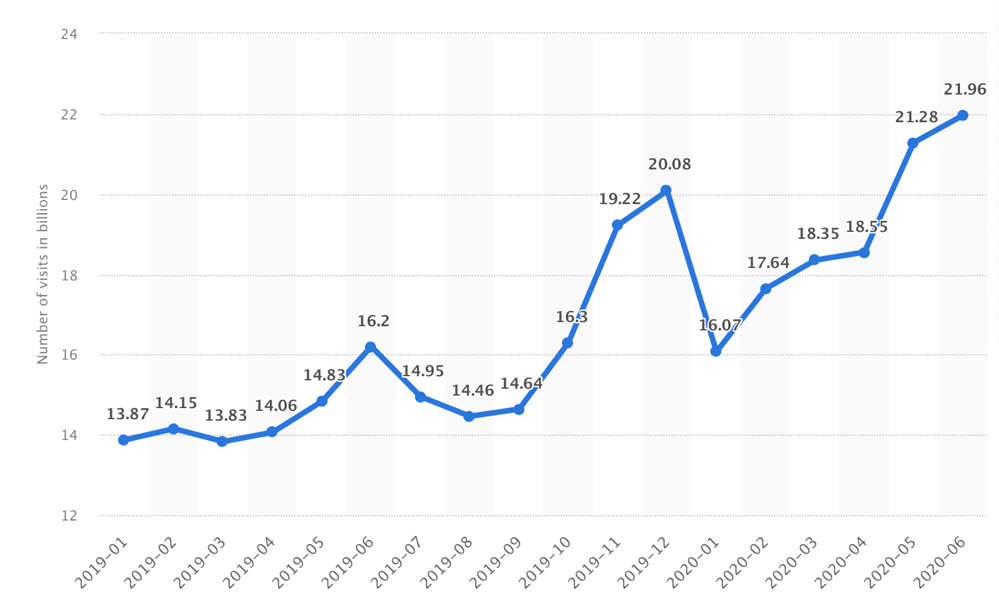
A large-scale online survey of respondents from nine different countries, including Russia, Italy, Switzerland, Turkey, Brazil, China, Germany, Korea, and South Africa, also evaluated online shopping patterns under COVID-19. The main finding of the report is that more than half of the respondents said they had become more likely to make online purchases (UNCTAD, 2020). Figure 6 makes it clear that all sales categories, except tourism, showed an increase in sales during the pandemic, but “personal care and cosmetics,” “health,” “education,” and housewares showed the most rapid growth. In other words, one can conclude that consumers who stayed at home paid more attention to themselves and their homes, which influenced sales growth in these sectors. Among the additional observations of the international report, rapid growth in e-commerce spending was seen in adult women with higher education, multinational conglomerates strengthened their position as market leaders, and the changes observed are likely to remain after COVID-19. According to Charm et al. (2020), the number of people who expect to continue shopping online after significant restrictions are lifted is increasing; consequently, the online shopping industry is steadily gaining ground as a profitable sovereign market. This pattern of online shopping can give young entrepreneurs the confidence to set up their stores, which will ultimately affect the diversity and fullness of the market.
It is impossible not to mention that during the pandemic, express courier deliveries have become particularly important as a way to shop online. Through websites and apps, consumers could order prepared food or groceries at home, which perfectly addressed the need for quarantine and individuals’ willingness to spend money on goods. Turning to the statistics in Figure 7 makes it clear that the most dramatic growth in the delivery market came in the first half of 2020 when quarantine measures and social exclusion requirements became most severe. Food delivery, as much as it seems, is a full-fledged part of online shopping, serving not only a utilitarian function but also covering the emotional need to shop.
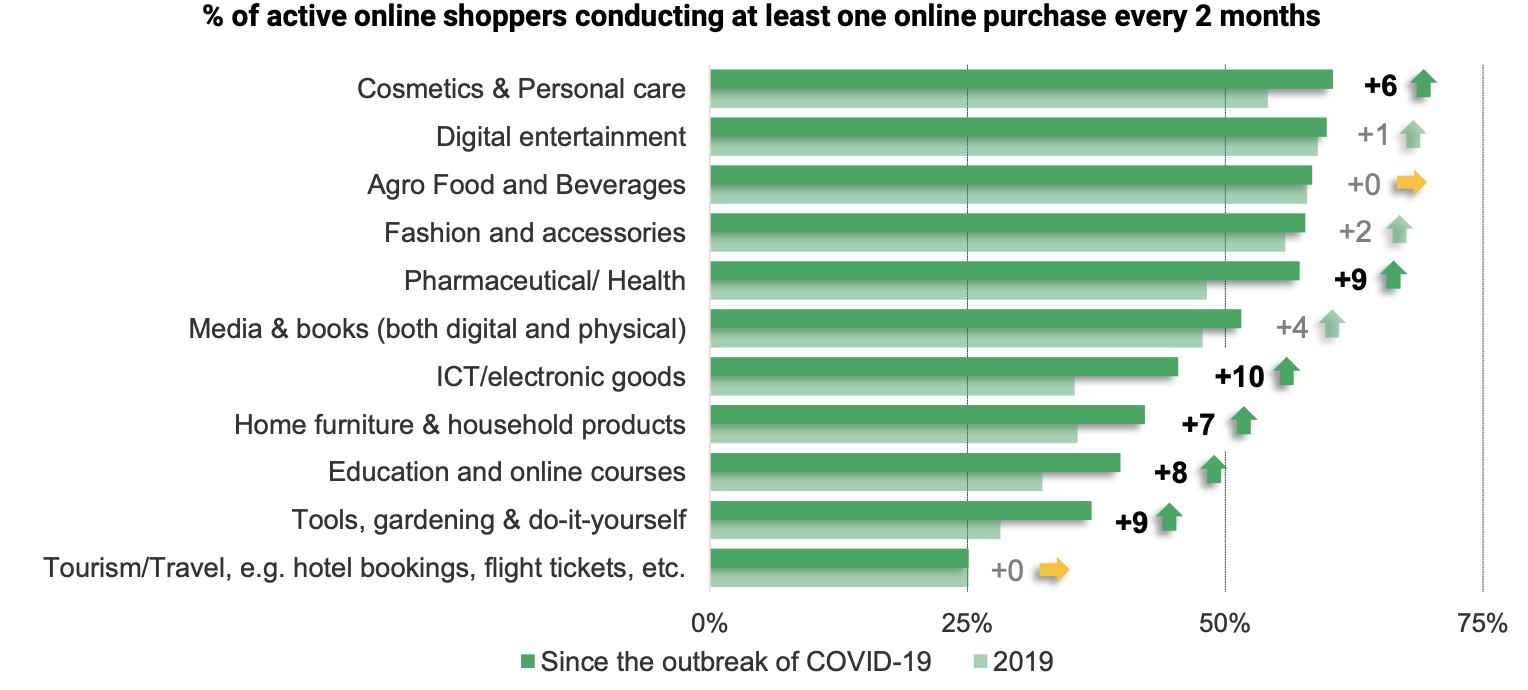
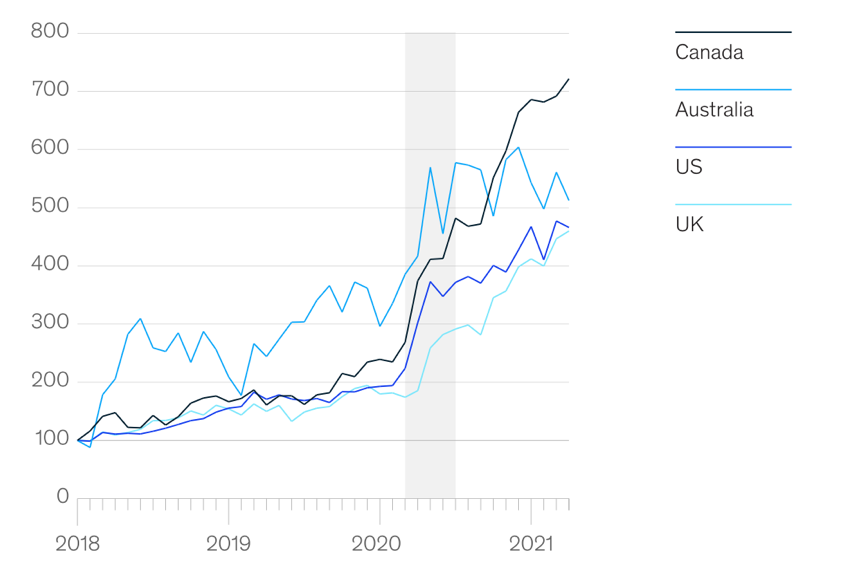
Among the noted patterns, caused including the action of COVID-19, is the variability of consumer behavior. Martinez-Ruiz and Moser (2019) noted that “understanding the psychology behind online consumer behavior is key to compete in today’s markets which are characterized by ever increasing competition and globalization” (p. 1). However, as found by Charm et al. (2020), today’s online consumer behavior is difficult to predict due to high variance. Figure 8 shows that 36% of respondents have tried different brands while shopping online, with nearly 3/4 of them stating an inclination to continue this tactic. In turn, this can pose a problem for companies, as the consumer, in this case, does not show loyalty to one brand but instead goes through them. An extremely interesting pattern was observed when analyzing particularly recent sources of scientific information. In particular, consumers are willing to be more loyal to those online shopping platforms that guarantee sanitary transparency (Puspita et al., 2021; Sarika and Murad, 2021). Treating packaging with disinfectants, employee health checks, and taking care of customers with gifts of masks, gloves, and hand gels: these are all new lessons in modern business that qualitatively increase customer engagement. It is hard to say that such patterns will remain relevant a few years from now when the traces of COVID-19 are finally gone, but right now, online shopping business models are undergoing such a milestone evolution.

Dynamic consumer behavior is also expressed in external pressures caused by reduced incomes. The effects of COVID-19 have an impact not only on the humanitarian crisis but also on the economic obstacles to growth (König and Winkler, 2020; Collings et al., 2021). Suspension of industries, disruption of supply chains, and a decline in people’s ability to work and real income. For the U.S., this drop was 1% or nearly $217 billion by the second half of 2021 (BEA, 2021). For the world, in OECD countries, the average income decline has reached 1.6% (OECD, 2021). In other words, consumers are rapidly losing money, which means the size of the potential grocery basket will decrease. This affects online shopping patterns, as making impulsive, spontaneous purchases become financially more difficult. Research shows that “consumers have shifted to more mindful shopping, with some trading down for value” (McKinsey, 2020, p. 8). This pattern is critical for online venues because it reflects the sales industry’s destructive tendency for consumers to save money on purchases. Consequently, the need for quality marketing management of such customer behavior is created.
Abstract Thinking as a Motivating Factor
The “cart abandonment” effect is an undesirable phenomenon for companies in which consumers abandon the payment procedure for items that have been added to the cart. Several factors can drive this effect, and Jiang, Zhang, and Wang (2021) pointed to customer forgetfulness and the design of the shopping cart section web page. Obviously, online platforms are not interested in this effect because it ultimately reduces company profits. For this reason, Rubin et al. (2020) find that consumers with an abstract mindset as opposed to a concrete mindset are less likely to show cart abandonment and thus increase the commercial value of an online platform. As a consequence, online retailers should invest in developing consumers’ abstract thinking rather than concrete-rational judgments
Impact on International Business
A review of the existing literature also highlighted the connection between the evolution of online shopping and positive contributions to international business. This has tended to be viewed from two angles. On the one hand, people forced to stay at home have become more creative, prompting them to monetize their creativity. Statistics show that the number of new businesses in the U.S. rose sharply in the summer of 2020, showing record growth for the first time in fifteen years, as reflected in Figure 9 (Rhyne, 2021). This may have had a positive effect on the international market as it visibly saturated national small business industries. The unique products of individual entrepreneurs of interest to foreigners could be delivered seamlessly between countries, stimulating the intensification of globalization processes. Meanwhile, even in 2022, when pandemics are no longer perceived as a severe problem and the number of vaccinated world residents has increased significantly, the destructive impact of restrictions on retail trade remains. It has been reported that U.S. retail sales fell 1.9% in December 2021 due to supply chain problems and concerns about contamination (Brooks and Allen, 2022). Thus, deprived of the ability to purchase goods offline, consumers naturally began to look for new ways to meet their shopping needs. Studies show that multinationals sales during the pandemic increased markedly (Nair et al. 2021; Bateman, 2021; Godar, 2021; Canon, 2021). It is reasonable to conclude that international business, although it has undergone structural changes in recent years, has otherwise shown positive growth.
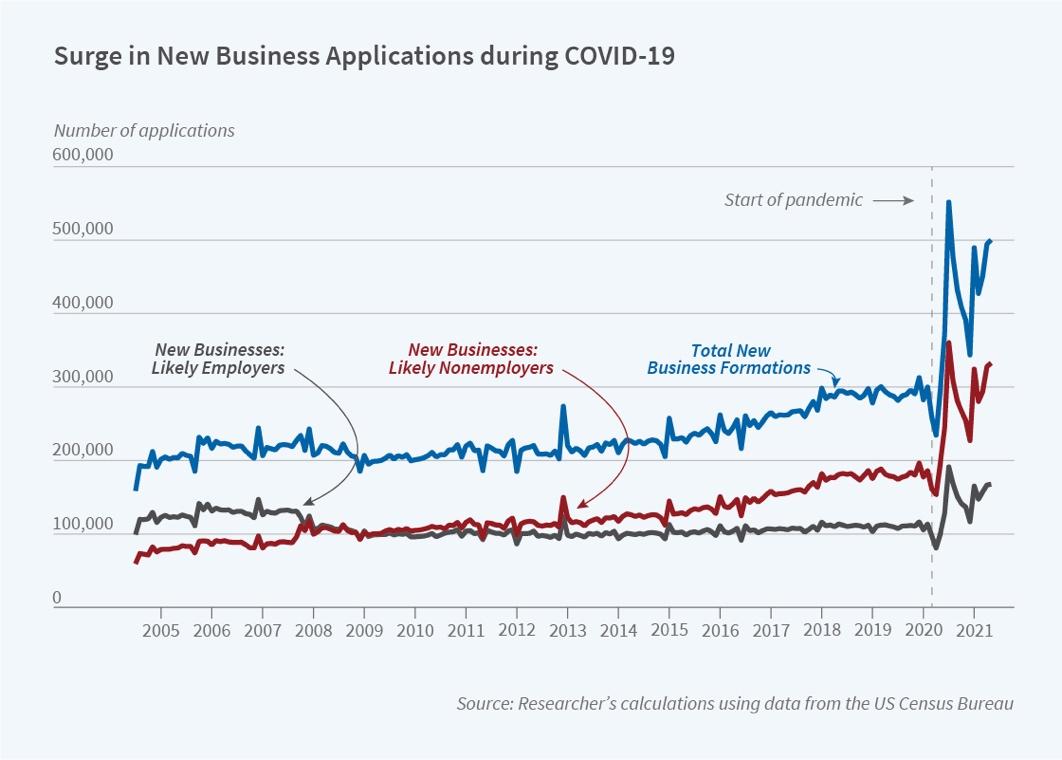
Impact on Retail Stores
There is concern among the academic community and the public as to whether online shopping can eventually replace offline shopping in the real world. On the one hand, the benefits of online shopping are clear: not only does it “save money, time, and effort,” but it also presents many marketing features that optimize the experience of interacting with the platform (Chelvarayan, Jie, and Fern, 2021, p. 13; Liu et al., 2019). This includes digital advertising in the online environment that is targeted based on user preferences. The product dispensing feed automatically adjusts to user interests, demographics, and geography, and advanced loyalty systems increase customer engagement with the company (Sahin, 2022; Lindecrantz, Gi, and Zerbi, 2020). Meanwhile, it is well known that online shopping has a positive effect on job growth, although the opposite trend is observed in the short-run (Shaw, 2020; Gherghina, Botezatu, and Simionescu, 2021). On the other hand, online shopping is still associated with the need for time-consuming delivery times, which is especially true when ordering products from overseas (Puri, 2018; Jules, 2020). Investing in convenience and personalization requires the consumer to sacrifice time in this way. Moreover, offline shopping opportunities allow the consumer to touch, try on, and feel the quality of the product with their own hands, which improves the speed of purchase decisions (Pino et al., 2020). Interestingly, offline shopping in malls is often hedonistic in nature and linked to subsequent leisure time in a food court or movie; this is not the case with online shopping (Ameen et al., 2020). Finally, it should not be forgotten that offline shopping turns out to be more convenient for people with a deficit of digital knowledge and low accessibility to computer technology. An interesting opinion on this issue was expressed from the urbanist perspective by Rao (2019). Rao highlighted concerns about replacing physical malls with online aggregators, which would result in large commercial spaces being abandoned; this creates environmental threats to online shopping (Joerss et al., 2021). The author finds that abandoned establishments do not remain as such but are effectively incorporated into the system of advanced urbanism of the city, modifying themselves into new public spaces. Otherwise, the procedures and motivations of online and offline shopping turn out to be highly similar.
In the meantime, there is a strong view in the academic field that online shopping has a negative impact on retail stores. By creating new platforms for selling goods on more attractive terms for the customer, online shopping triggers natural competition mechanisms, resulting in which retail stores die (Maat and Konings, 2018). Moreover, online retailers appear to be more adaptable to survive, clearly evident during a pandemic. It is pointed out that “big-box stores have been hit hard by shutdowns and inflation just as more people and companies are focusing on online sales” (Gore, 2021, para. 2). There are fears that up to nine percent of all U.S. retail stores will close their doors (Wahba, 2021). This includes not only the closure of some branch stores of retail chains like CVS, Bed Bath & Beyond, and American Eagle but also the complete closure of stores that have not been able to withstand the economic pressures of online shopping (Grill-Goodman, 2021; Gore, 2020; Gore, 2021). These developments occur in parallel with the intensification of e-commerce growth and the opening of more and more new online platforms; hence, the disruptive impact of online shopping on retail stores cannot be overstated. On the other hand, retail store closures are becoming the reason for the increase in online platforms, as Sheth reports that “e-commerce will grow faster due to the pandemic lockdowns and store closings” (Sheth, 202, p. 599). Consequently, there are clear causal links for the system of countering online shopping and retailing that work both ways.
Methodology
Research Design
The methodological foundation of this research work was built on the principle of a systematic review of academic sources. Establishing answers to the specific research question identified in the Introduction is what determines the explanatory nature of the methodological approach; the review was not aimed at finding general descriptions and evidence, but rather an academic analysis of the available information needed to answer the research question. For this reason, the research design should be called qualitative, as the critical question was to determine what patterns influence online shopping patterns but not to quantify them.
Data Collection
The current study used primary and secondary data free in the academic field to summarize, review, and interpret the patterns found. Given the breadth of the research question, a large number of authoritative and reliable sources had to be used. To accomplish this, a systematic approach to information retrieval was used based on five factors of inclusion. First, all materials used had to be written no earlier than 2018. Second, the writing language of each article had to be English. Third, the research did not have to focus only on the United States, so different geographic regions of the study were chosen. Fourth, the credibility of the author and the publication in which the article was published had to be valid. Reliability was tested by evaluating the thematic affiliation of the journal and additional works by a particular author; situations in which the researcher published material from unrelated disciplines were excluded. Finally, the full-text format must be available for any material used, either at no charge or through a subscription to publications through the university. No academically unethical procedures for plagiarism, copying, or theft of research papers were implemented.
All research was collected through three digital platforms: Google, Google Scholar, and Web of Science. Each of the search engines allowed for fine-tuning of queries, use of keywords, and filtering of results. Thus, among the keywords used were the following patterns: “online shopping” AND “customer satisfaction” OR “consumer trust” OR “globalization.”The use of particular terms significantly reduced the output of potentially valuable works and detailed literature reviews.
Data Analysis
The literature search was a fundamental tool for obtaining academic materials, which were processed through thematic analysis. Qualitative analysis of academic articles was thus accomplished through careful reading of various sources, then grouping them by thematic context and using them in the literature review. A summary diagram showing the grouping of sources is shown in Figure 10 below. This is a reasonably flexible approach for generalizing and generating new academic ideas since the search and processing procedures and clustering are entirely dependent on the choice of research strategy. In addition to academic data, open public and commercial reports, case studies for specific markets, and government documents were also used, all of which allowed us to look at the analyzed problem from an alternative perspective.
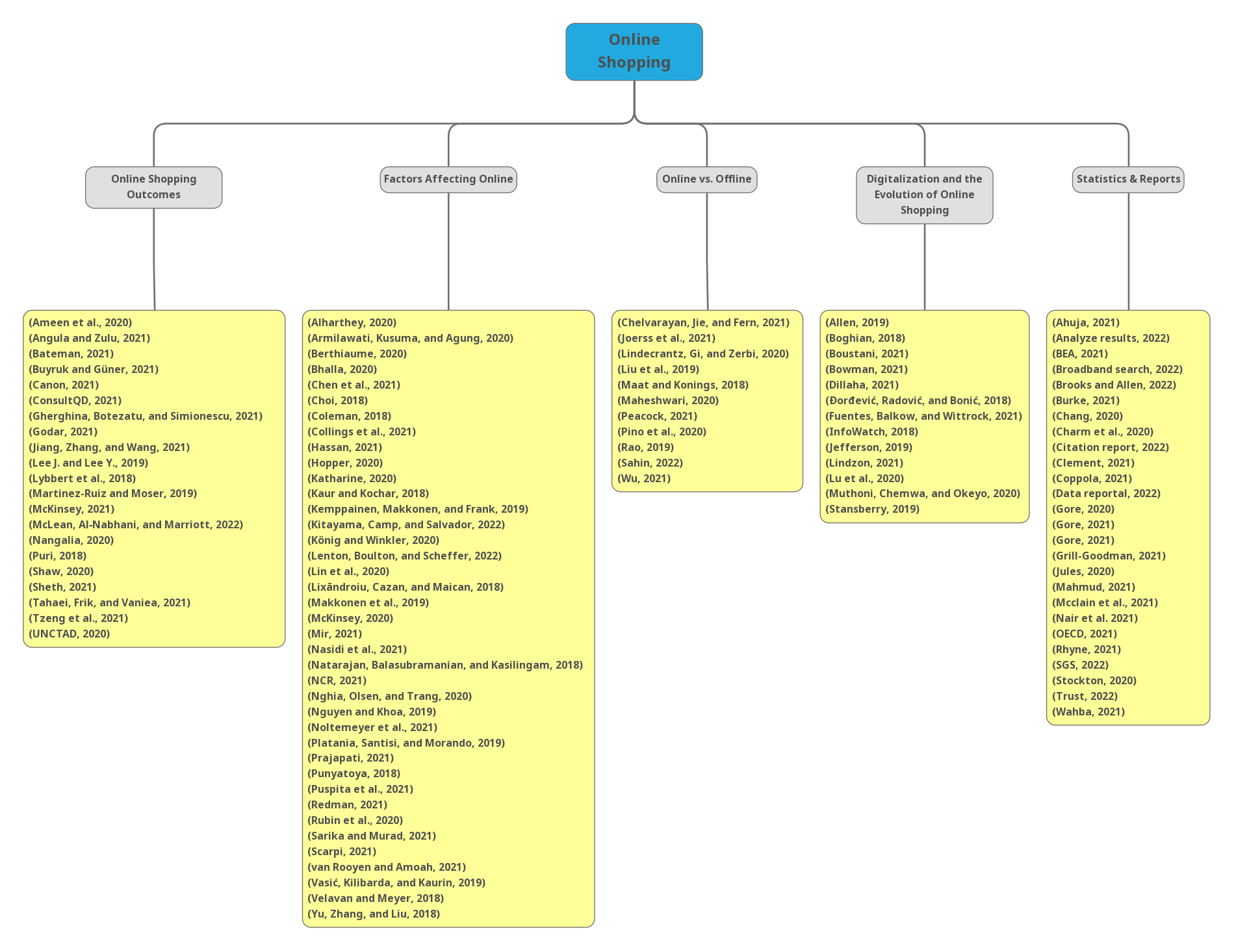
Data Findings
The cluster method for clustering and subsequent analysis of the sources used demonstrated strategic value for the purposes of the current study. The total number of papers used was 110, of which 74% were academic studies; the remaining 26% came from the public, government, and commercial papers. The chronological distribution of the used works is shown in Figure 11 — it is clearly visible that the overwhelming majority of the used studies were published in the last two years, which is not surprising, considering the significance of COVID-19 as one of the central factors influencing the evolution of online shopping.

The evolution of online shopping as a phenomenon acted as a kernel, for which factors and motivations that have an impact were identified. The final result is demonstrated in Figure 12: it is a conceptual map of the patterns found, answering the research question. The direction of the arrow demonstrates the direction of influence: thus, affective trust, emotion, the need to cover utilitarian functions, and abstract thinking were shown to influence changes in online shopping patterns unambiguously. Meanwhile, customer satisfaction, the aesthetic component, and COVID-19 — among which perceptions of hygiene requirements — had a bidirectional influence on online shopping: on the one hand, they had an important influence on changing patterns, but on the other hand, they themselves changed under the evolution of online shopping. The unique synthesis of the incoming factors ultimately led to increased sales on specific platforms, which is the final goal of Internet marketers and entrepreneurs.
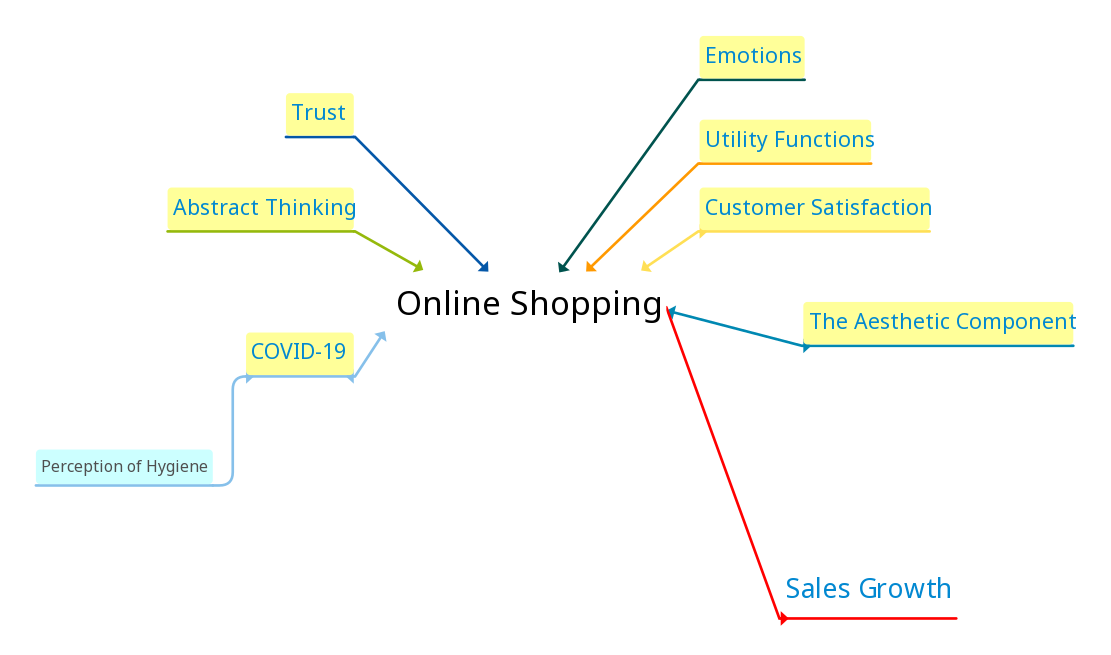
Meanwhile, the influence factors were found to have a generally positive relationship with international business development. Among the main findings, it was found that, first, online shopping encourages new entrepreneurs to join the single market, which increases the saturation of national markets with small businesses; in other words, “digital technology might encourage entrepreneurship” (Allen, 2019). Second, with the intensification of globalization processes, economic cooperation between countries is becoming closer. For this reason, not only multinational companies but also medium and small entrepreneurs can almost freely sell goods and services abroad. However, external threats can significantly affect the effectiveness of online shopping because “the risks associated with online products and retailers significantly determine consumer confidence” (Lixăndroiu, Cazan, and Maican, 2018, p. 2). Thus, COVID-19 disrupted sustainable supply chains in the first months and affected the labor capacity of the population, due to which real incomes of citizens experience a fall to this day. Nevertheless, COVID-19 led to an increase in profits for large companies through the implementation of restrictive measures; citizens were locked in at home, which led to an increase in sales for products for personal well-being and health, as well as for home repairs.
While it has been shown that online shopping can have a disruptive effect on brick-and-mortar stores, the reality is that physical stores are capable of adapting to change. This was expressed in a study by Angula and Zulu that “the threat of online shopping propels brick-and-mortar retailers to innovate and design their retail atmosphere to create unforgettable shopping experiences to compete effectively and retain customers” (Angula and Zulu, 2021, p. 157). Faced with obstacles in the form of online shopping, many retailers will naturally die out due to insufficient resources and strength to compete effectively. However, the rest will launch change management mechanisms to survive in the pressured environment. In addition, not all offline retail branches can be entirely replaced: while non-essential goods, groceries, and medicines can be ordered online, goods or services consumed locally cannot be replaced by digital technologies. This applies to coffee shops and quick-service restaurants. While these are not full-fledged stores, they are still physical retail outlets for food and services. For example, retail coffee shops have shown a systematic increase in sales, including a 5380% increase during the pandemic (Stockton, 2020). Moreover, some products in most countries cannot generally be bought online: this is the case for cigarettes and alcohol, whose distribution through physical networks is controlled through a system of excise taxes (Coleman, 2018). Thus, it is appropriate to conclude that brick-and-mortar retailers are undergoing a need to transform under the pressure of online shopping and the pandemic, but many of them successfully undergo this evolution and remain viable.
Thus, it is correct to postulate, based on the available data, that online shopping as a system is proving to be dynamic and unstable. Although the factors found systematically influence the evolution of online shopping, this influence is not always unambiguous. Overall, online shopping has been found to have a significant impact on international business, allowing an increasing number of start-up entrepreneurs to join sales, increasing sales, and creating new jobs.
Meanwhile, it is critical to recognize that online shopping is not exhaustive in its significance for international trade and cannot become a substitute for offline shopping. Although digitalization is deepening and more people are using the Internet, “online shopping cannot replace physical outlets” because of severe limitations (Nangalia, 2020). Not all consumers are inclined to trust online platforms, and for many, issues of product quality, which can only be determined in person, are paramount. Thus, the research conducted was able to answer all of the stated questions.
Discussion
The purpose of this research paper was to determine the key factors that influence online shopping patterns and connections to international business. Online shopping is a phenomenal milestone in the development of entrepreneurship, taking advantage of the profound digitalization of different areas of life. As computers, smartphones, and tablets with Internet access have been used by up to 62.5% of the world’s population, e-commerce is clearly finding potential for growth (Data reportal, 2022). The percentage of users joining mobile technology is steadily increasing as its overall accessibility increases, and more and more seniors understand the integral use of digitalization in their lives (Stansberry, 2019) and (Jefferson, 2019). Notably, cell phones remain the leading type of technology from which the most online purchases are made, and this statistic is showing an upward trend (Broadband search, 2022). This is confirmed by market share dynamics: by early 2022, 55.04% of the global electronic market share was held by phones, and only 42.48% by desktops (SGS, 2022). As a consequence, it creates an urgent need to match the growth rate of the e-commerce market with consumer expectations.
Nevertheless, the system of “customer expectations” does not turn out to be unambiguous for a universal interpretation since each company, state, community, and shopping category has its own expectations. It is understandable that no one will wait weeks for delivery of ordered products, as is the case with clothing from the countries; nevertheless, in both cases, some phenomenal expectation of reliability of the online supplier is created. It is the belief in this reliability that has been shown in research to be the central core of trust as a significant influence on online shopping patterns (Figure 12). This aligns perfectly with the many scholarly works demonstrating the importance of trust, such as Bhalla (2020) and Punyatoya (2018). Although trust is based on feelings of personal safety, some recent research shows an alternative view: “risk perception has no proven effect on consumer purchase intentions” (Armilawati, Kusuma, and Agung, 2020, p. 21787). This study did not clarify exactly what type of trust is used, so it is appropriate to say that, as in the results found, there really is no proven effect on online purchase intentions for cognitive trust (Nghia et al., 2020). Consequently, when using trust as a variable, it should be stated what exactly is meant by such trust in order to avoid confusion.
Additional factors have been identified that directly influence online shopping patterns. Examination of academic sources will make it clear that these factors are often found as significant influence categories, as shown in Figure 13. However, any inconsistencies with studies in which alternative variables (e.g., age or ethnicity) are found are due to the specification of such studies and the narrowing of the scope (Natarajan, Balasubramanian, and Kasilingam, 2018). Otherwise, the conceptual map reflected in Figure 12 reflects a basic plurality of categories of influence on the structure of online shopping and its development.
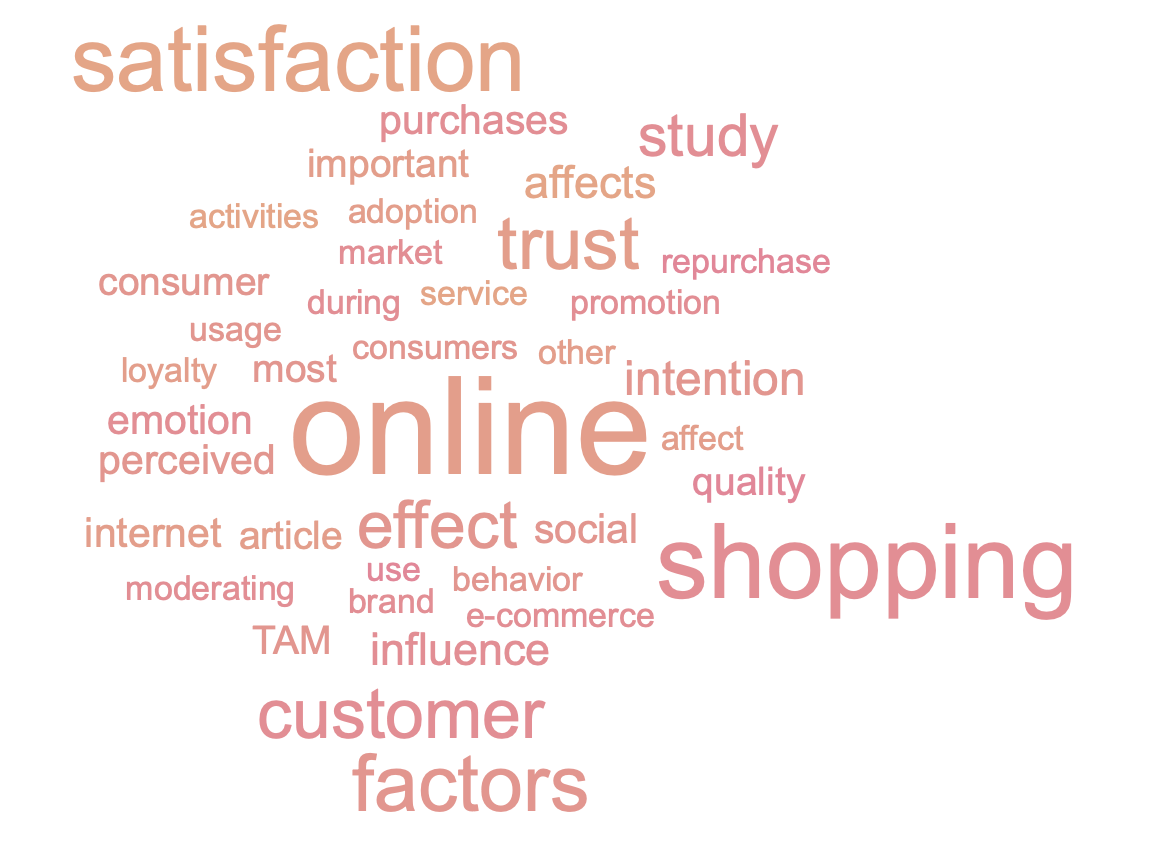
The literature review also showed that retail stores could not be entirely replaced by online shopping because there are serious limitations. Although the shift toward e-commerce is tangible, online shopping does not (and hardly will) solve the issues associated with in-person interaction with goods before purchase, learning about their organoleptic properties, and making a decision on the spot. Retail stores are known to increase reach significantly, so “supermarkets and independent retail shops remain a vital part of the…distribution infrastructure…” (Nangalia, 2020). Thus, retail stores remain relevant, and even with the increasing development of Internet technology, it seems that the unique relevance of brick-and-mortar stores will not disappear but will be modified.
Theoretical Contributions
The research conducted has qualitatively summarized the available knowledge and proposed a conceptual model of online shopping as a system dependent on multiple factors. The trust dualism found in the study is in excellent agreement with the published Shopping Continuum Theory, which considers the influence of affects and cognitive functions on online shopping (Choi, 2018). At the same time, the study showed the surprising resilience of retail stores in the face of mass digitalization. As a consequence, the study addresses a relevant theoretical question about the ability of online stores to satisfy the entire market and become a complete replacement for brick-and-mortar stores.
Managerial/Practical/Policy Contributions
The patterns found and their descriptions make sense for market research because they essentially reflect what factors should be considered when creating a profitable online platform. Experienced marketers can thus significantly increase customer engagement and loyalty, as well as impact sales growth if they make use of the connections described in the paper. Moreover, the deepening digitalization of society means that each individual gets a taste of being an entrepreneur, so the lessons described in the previous sections will be strategically valuable for aspiring businesspeople.
Research Limitations and Areas for Future Research
Research has the potential to grow further because several limitations have been inherent in it. In particular, the use of available data, even with validity experiments, can be associated with systematic errors (ConsultQD, 2021). In addition, the work is explanatory in nature but lacks innovative approaches to uncover potentially hidden patterns. Finally, the number of sources was limited, which means that not all of their possible subtopics were covered. Expanding the theoretical framework by designing our own experiments is one of the priority ways to develop the research project. In addition, an interesting milestone could be a meta-comparison of online shopping for different countries in order to explore national experiences and identify possible connections to ethnic, economic, political, and cultural characteristics of the region.
Recommendations and Implications
Based on the patterns found, it is reasonable to develop several recommendations that would be applicable to stakeholders. In particular, people involved in e-commerce and retailing, regulators of the economic system, and members of the academic community are implied. First, there is no need to worry that online shopping will have a lethal effect on retailing since they are not mutually exclusive channels. Second, there is a need for entrepreneurs at any level (online or offline) to adapt to change in order to remain viable in the face of external pressures and competition. Thirdly, there is no guarantee that future problems similar to COVID-19 will not be repeated: therefore, companies are advised to assess the lessons learned from this pandemic and prepare for future threats in advance by building contingency funds. Fourthly, the head of online e-commerce platforms should adhere to a comprehensive system for business management because enough factors have been identified that have the potential to affect the profitability of online shopping. Fifthly, it is recommended that academics make an effort to do more in-depth, evidence-based research on the phenomenon of online shopping, as a deficit of accurate knowledge has been found.
The implications of the qualitative research conducted to demonstrate how dynamic online shopping is and how many factors influence business. Using the insights gained will be useful for online shopping executives to tune content personalization systems more sensitively and thus increase user engagement, resulting in increased profits. The implications for local economic regulators demonstrate that online shopping is an essential component of the national economy, and stimulating the development of this sector is necessary. Failure to develop regulations for this area of commerce can lead to an increase in illegal stores and fraudulent schemes, which has a crippling effect on the economy. For retail store managers, the implications lie in assessing the potential outcomes of offline business in the face of the intensification of online shopping.
Conclusion
To summarize, online shopping is an essential phenomenal feature of modern entrepreneurial development. The emergence and widespread adoption of digital technologies have created a demand for an expansion of their range of action; among other things, this has affected commerce. The emergence of e-commerce was a natural milestone in this evolution and was significantly amplified during the pandemic when online shopping became the only way to satisfy shopping needs. Several cognitive factors and perceptions have been shown to influence online shopping patterns at once, and these influences have not continually been unequivocally assessed. Meanwhile, it has been shown that online shopping can harm the retail system, leading to reduced profits and fewer branches. Nevertheless, if physical stores can adapt to the pressures of online shopping, this will keep their chances of survival. Finally, not all areas of retailing can be replaced by online shopping since not all products or services can be obtained through the Internet.
Reference List
Ahuja, K., Chandra, V., Lord, V., and Peens, C. (2021) Ordering in: the rapid evolution of food delivery. Web.
Alharthey, B. (2020) ‘The role of online trust in forming online shopping intentions,’ International Journal of Online Marketing (IJOM), 10(1), pp. 32-57.
Allen, J.P. (2019) Digital entrepreneurship. London: Routledge.
Ameen, N., Tarhini, A., Shah, M. and Madichie, N.O. (2020) ‘Going with the flow: smart shopping malls and omnichannel retailing,’ Journal of Services Marketing, 35(3), pp. 325-348.
Analyze results (2022) Web.
Angula, E. and Zulu, V.M. (2021) ‘Tackling the ‘death’of brick-and-mortar clothing retailers through store atmospherics and customer experience,’ Innovative Marketing, 17(3), pp. 157-168.
Armilawati, N.L.P.D., Kusuma, I.G.A.T. and Agung, A.P. (2020) ‘The effect of online shopping experience on risk p erception and trust for building online repurchase intention,’ International Journal of Contemporary Research and Review, 11(05), pp. 21787-21797.
Bateman, T. (2021) Record profits for Apple, Microsoft and Google amid COVID-19 boost for big tech. Web.
BEA (2021) Personal income and outlays, september 2021. Web.
Berthiaume, D. (2020) Survey: consumers are unhappy with online shopping. Web.
Bhalla, S. (2020) ‘Demystifying the key antecedents of consumer trust in online shopping and testing the mediating role of consumer trust: an empirical study,’ IUP Journal of Marketing Management, 19(1), pp. 7-22.
Boghian, I. (2018) ‘Methodological guidelines for elaborating the curriculum of intercultural education with a focus on the values of tolerance,’ Revista Românească pentru Educaţie Multidimensională, 10(4), pp. 249-264.
Boustani, G. (2021) Pop-up retail: the evolution, application and future of ephemeral stores. London: Routledge.
Bowman, E. (2021). After data breach exposes 530 million, Facebook says it will not notify users. Web.
Broadband search (2022) Mobile vs. desktop internet usage (latest 2022 data). Web.
Brooks, B. and Allen, J. (2022) ‘Upside down again’: omicron surge roils U.S. small businesses. Web.
Burke, M. (2021) Top online retailers in USA – 2021 report. Web.
Buyruk, M. and Güner, E. (2021) ‘Personalization in airline revenue management: an overview and future outlook,’ Journal of Revenue and Pricing Management, pp.1-11.
Canon, G. (2021) Apple sales rise to $90bn amid Covid buying surge. Web.
Chang, V. (2020) Tablet sales boosted by Covid-19 pandemic lockdown measures. Web.
Charm, T., Coggins, B., Robinson, K., and Wilkie, J. (2020) The great consumer shift: Ten charts that show how US shopping behavior is changing. Web.
Chelvarayan, A., Jie, C.S. and Fern, Y.S. (2021) ‘Factors affecting students’ perception of online shopping,’ International Journal of Entrepreneurship, Business and Creative Economy, 1(1), pp. 13-24.
Chen, S.J., Waseem, D., Xia, Z.R., Tran, K.T., Li, Y. and Yao, J. (2021) ‘To disclose or to falsify: the effects of cognitive trust and affective trust on customer cooperation in contact tracing,’ International Journal of Hospitality Management, 94, pp. 1-7.
Choi, E.J. (2018) A new shopping choice proposition:“shopping continuum theory” for online shopping. Web.
Citation report (2022) Web.
Clement, J. (2021) COVID-19 impact on global retail e-commerce site traffic 2019-2020. Web.
Coleman, T. (2018) Why is it you can buy alcohol online but not tobacco? Web.
Collings, D.G., Nyberg, A.J., Wright, P.M. and McMackin, J. (2021) ‘Leading through paradox in a COVID‐19 world: human resources comes of age,’ Human Resource Management Journal, 31(4), pp. 819-833.
ConsultQD (2021) Study uncovers serious shortcomings of systematic reviews in top cardiology journals. Web.
Coppola, D. (2021) Global number of digital buyers 2014-2021. Web.
Data reportal (2022) Digital around the world. Web.
Dillaha, O. (2021) Regulatory entrepreneurship: the simultaneuos evolution of business and law. Web.
Đorđević, M., Radović, O. and Bonić, L. (2018) ‘Potentials for applying cloud technology in accounting,’ Ekonomika, 64(3), pp. 23-30.
Fuentes, C., Balkow, J. and Wittrock, H. (2021) Mobile shopping from home: Digitalization and the reconfiguration of domestic retailscapes. Web.
Gherghina Ș. C., Botezatu M. A., and Simionescu L. N. (2021) ‘Exploring the impact of electronic commerce on employment rate: panel data evidence from European Union countries,’ Journal of Theoretical and Applied Electronic Commerce Research, 16(7), pp. 3157-3183.
Godar, S. (2021) Multinational enterprises’ profits and activity. Web.
Gore, L. (2020) Bed Bath & Beyond closing 200 stores; 2 Alabama locations among 63 first to close. Web.
Gore, L. (2021) CVS to close 900 stores over next 3 years. Web.
Gore, L. (2021) Retail store closings 2021: the list of chains that closed stores this year. Web.
Grill-Goodman, J. (2021) American Eagle to close at least 200 mall-based stores. Web.
Hassan, M. (2021) ‘Impact of Emotions during Online Shopping on University Students,’ International Journal of Empirical Finance and Management Sciences, 06, pp. 1-8.
Hopper, E. (2020) Maslow’s hierarchy of needs explained. Web.
InfoWatch (2018) Global data leakage report, 2017. Web.
Jefferson, R. J. (2019) More seniors are embracing technology. But can they use it? UCSD researchers suggest asking them. Web.
Jiang, D., Zhang, G. and Wang, L. (2021) ‘Empty the Shopping Cart? The effect of shopping cart item sorting on online shopping cart abandonment behavior,’ Journal of Theoretical and Applied Electronic Commerce Research, 16(6), pp. 1973-1996.
Joerss, T., Hoffmann, S., Mai, R. and Akbar, P. (2021) ‘Digitalization as solution to environmental problems? When users rely on augmented reality-recommendation agents,’ Journal of Business Research, 128, pp. 510-523.
Jules (2020) How long does international shipping take? Web.
Katharine (2020) The perfect shipping communication: what does it look like?Web.
Kaur, H. and Kochar, R. (2018) ‘A review of factors affecting consumer behavior towards online shopping,’ International Journal of Engineering and Management Research (IJEMR), 8(4), pp. 54-58.
Kemppainen, T., Makkonen, M. and Frank, L. (2019) ‘Exploring online customer experience formation: how do customers explain negative emotions during online shopping encounters,’ Bled eConference, pp. 665-675.
Kitayama, S., Camp, N.P. and Salvador, C.E. (2022) ‘Culture and the COVID‐19 pandemic: multiple mechanisms and policy implications,’ Social Issues and Policy Review, 16(1), pp. 164-211.
König, M. and Winkler, A. (2020) ‘COVID-19 and economic growth: does good government performance pay off,’ Intereconomics, 55(4), pp. 224-231.
Lee, J. and Lee, Y. (2019) ‘Does online shopping make consumers feel better? Exploring online retail therapy effects on consumers’ attitudes towards online shopping malls,’ Asia Pacific Journal of Marketing and Logistics, 31(2), pp. 464-479.
Lenton, T.M., Boulton, C.A. and Scheffer, M. (2022) ‘Resilience of countries to COVID-19 correlated with trust,’ Scientific Reports, 12(1), pp. 1-15.
Lin, L.W., Yan, S.R., Zhou, J.L. and Kaluri, R. (2020) ‘Cross-border shopping on consumer satisfaction survey-the case of COVID-19 was analyzed,’ Saudi Journal of Business and Management Studies, 5(03), pp. 196-199.
Lindecrantz, E., Gi, M. T. P. and Zerbi, S. (2020) Personalizing the customer experience: driving differentiation in retail. Web.
Lindzon, H. (2021) Digital innovation at speed and cost. Web.
Liu, Y., Zhao, Z., Wu, X., Zhu, M. and Qiu, C. (2019) ‘Research on the influence of online shopping characteristics on consumers’ shopping intention,’ International Conference on Information and Social Science, pp. 285-293.
Lixăndroiu, R., Cazan, A.M. and Maican, C.I. (2021) ‘An analysis of the impact of personality traits towards augmented reality in online shopping,’ Symmetry, 13(3), pp. 1-18.
Lu, C.X., Li, Y., Xiangli, Y. and Li, Z. (2020) ‘Nowhere to hide: cross-modal identity leakage between biometrics and devices,’ Proceedings of The Web Conference, pp. 212-223.
Lybbert, T.J., Magnan, N., Spielman, D.J., Bhargava, A.K. and Gulati, K. (2018) ‘Targeting technology to increase smallholder profits and conserve resources: experimental provision of laser land-leveling services to Indian farmers,’ Economic Development and Cultural Change, 66(2), pp. 265-306.
Maat, K. and Konings, R. (2018) ‘Accessibility or innovation? Store shopping trips versus online shopping,’ Transportation Research Record, 2672(50), pp. 1-10.
Maheshwari, D. (2020) ‘Online vs offline shopping,’ IJCRI-International Journal of Creative Research & Innovation, 2(1), 1-9.
Mahmud, M. (2021) ‘Case comparison of major digital business platforms: Amazon, AliExpress and eBay,’ Turkish Journal of Computer and Mathematics Education (TURCOMAT), 12(3), pp. 5801-5808.
Makkonen, M., Riekkinen, J., Frank, L. and Jussila, J. (2019) ‘The effects of positive and negative emotions during online shopping episodes on consumer satisfaction, repurchase intention, and recommendation intention,’ Bled eConference, pp. 932-954.
Martinez-Ruiz, M.P. and Moser, K.S. (2019) ‘Studying consumer behavior in an online context: the impact of the evolution of the world wide web for new avenues in research,’ Frontiers in Psychology, 10, pp. 1-2.
Mcclain, C., Vogels, E.A., Perrin, A., Sechopoulos, S., and Rainie, L. (2021) The Internet and the Pandemic. Web.
McKinsey (2020) A global view of how consumer behavior is changing amid COVID-19. Web.
McKinsey (2021) The value of getting personalization right—or wrong—is multiplying. Web.
McLean, G., Al‐Nabhani, K. and Marriott, H. (2022) ‘‘Regrettable‐escapism’the negative effects of mobile app use: a retail perspective,’ Psychology & Marketing, 39(1), pp. 150-167.
Mir, I.A. (2021) ‘Self-escapism motivated online shopping engagement: a determinant of users’ online shopping cart use and buying behavior,’ Journal of Internet Commerce, pp.1-34.
Muthoni, S., Chemwa, G. and Okeyo, G. (2020) ‘A cloud-based business continuity framework for universities,’ CEUR, pp. 1-4.
Nair, R.K., Reddy, L.S., Verma, P., Pandey, R., Yuwono, S., Sin, L.G., Qi, W.Y., Kee, D.M.H., Gee, O.X., Ing, T.W.S. and Yu, T.P. (2021) ‘The impact of COVID 19 towards international business strategy: a study of Coca-Cola company,’ International Journal of Accounting & Finance in Asia Pasific (IJAFAP), 4(2), pp. 73-92.
Nangalia, S. (2020) Shift AU creates research-by-design market to control COVID-19 contamination. Web.
Nasidi, Q. Y., Ahmad, M. F. Bin, and Hassan, I. (2021) ‘Mediating role of social media in the relationship between reliability, perceived usefulness on online shopping behaviour: building a conceptual framework,’ International Journal of Academic Research in Business and Social Sciences, 11(2), 385-393.
Natarajan, T., Balasubramanian, S.A. and Kasilingam, D.L. (2018) ‘The moderating role of device type and age of users on the intention to use mobile shopping applications,’ Technology in Society, 53, pp. 79-90.
NCR (2021) A shift in behavior: why grocery shoppers are going digital. Web.
Nghia, H.T., Olsen, S.O. and Trang, N.T.M. (2020) ‘Shopping value, trust, and online shopping well-being: a duality approach,’ Marketing Intelligence & Planning, 38(5), pp. 545-558.
Nguyen, H.M. and Khoa, B.T. (2019) ‘The relationship between the perceived mental benefits, online trust, and personal information disclosure in online shopping,’ The Journal of Asian Finance, Economics and Business, 6(4), pp. 261-270.
Noltemeyer, A., James, A.G., Bush, K., Bergen, D., Barrios, V. and Patton, J. (2021) ‘The relationship between deficiency needs and growth needs: the continuing investigation of Maslow’s theory,’ Child & Youth Services, 42(1), pp. 24-42.
OECD (2021) Household income in the OECD area fell sharply in the second quarter of 2021, despite strong growth in GDP. Web.
Peacock, L. (2021) Product pricing strategy guide: common types & examples. Web.
Pino, G., Amatulli, C., Nataraajan, R., De Angelis, M., Peluso, A.M. and Guido, G. (2020) ‘Product touch in the real and digital world: how do consumers react,’ Journal of Business Research, 112, pp. 492-501.
Platania, S., Santisi, G. and Morando, M. (2019) ‘Impact of emotion in the choice of eco-luxury brands: the multiple mediation role of the brand love and the brand trust,’ Calitatea, 20(S2), pp. 501-506.
Prajapati, V. (2021) Why do people shop online? – top 10 reasons you can’t ignore. Web.
Punyatoya, P. (2018) ‘Effects of cognitive and affective trust on online customer behavior,’ Marketing Intelligence & Planning, pp. 1-18.
Puri, A. (2018) The psychology of waiting for a parcel. Web.
Puspita, R.E., Zulaikha, Y., Annisa, A.A., Nabila, R., Rofiuddin, M. and Anwar, S. (2021) ‘Online shopping behavior among food consumers during pandemic: a cross generation study,’ E3S Web of Conferences, 317, pp. 1-8.
Rao, F. (2019) ‘Resilient forms of shopping centers amid the rise of online retailing: Towards the urban experience,’ Sustainability, 11(15), pp. 1-25.
Redman, R. (2021) Increased use of online grocery shopping ‘here to stay’. Web.
Rhyne, B. M. (2021) Business formation surged during pandemic and remains strong. Web.
Rubin, D., Martins, C., Ilyuk, V. and Hildebrand, D. (2020) ‘Online shopping cart abandonment: a consumer mindset perspective,’ Journal of Consumer Marketing, 37(5), pp. 487-499.
Sahin, B. (2022) E-commerce personalization: 2022 complete guide. Web.
Sarika, F. and Murad, S. (2021) ‘Retailer’s Strategy in reshaping consumers’ satisfaction and wellbeing during a pandemic,’ Advances in Social Science, Education and Humanities Research, 585, pp. 377-385.
Scarpi, D. (2021) ‘A construal-level approach to hedonic and utilitarian shopping orientation,’ Marketing Letters, 32(2), pp. 261-271.
SGS (2022) Desktop vs mobile vs tablet market share worldwide. Web.
Shaw, N. (2020) What the growth of e-commerce means for employment opportunities. Web.
Sheth, J.N. (2021) ‘Future of brick-and-mortar retailing: how will it survive and thrive,’ Journal of Strategic Marketing, 29(7), pp. 598-607.
Stansberry, K. (2019) Experts optimistic about the next 50 years of digital life. Web.
Stockton, B. (2020) 26 eye-opening coffee statistics for startups. Web.
Tahaei, M., Frik, A. and Vaniea, K. (2021) ‘Deciding on personalized ads: nudging developers about user privacy, Seventeenth Symposium on Usable Privacy and Security, pp. 573-596.
Trust (2022) Web.
Tzeng, S.Y., Ertz, M., Jo, M.S. and Sarigöllü, E. (2021) ‘Factors affecting customer satisfaction on online shopping holiday,’ Marketing Intelligence & Planning, 39(4), pp. 516-532.
UNCTAD (2020) COVID-19 and e-commerce findings from a survey of online consumers in 9 countries. Web.
van Rooyen, K.J.M. and Amoah, F. (2021) ‘Online shopping experiences: a quantitative investigation into hedonic value, trust, and risk in the South African retail industry,’ The Retail and Marketing Review, 17(2), pp. 17-29.
Vasić, N., Kilibarda, M. and Kaurin, T. (2019) ‘The influence of online shopping determinants on customer satisfaction in the Serbian market,’ Journal of Theoretical and Applied Electronic Commerce Research, 14(2), pp. 70-89.
Velavan, T.P. and Meyer, C.G. (2020) ‘The COVID‐19 epidemic,’ Tropical Medicine & International Health, 25(3), pp. 1-8.
Wahba, P. (2021) UBS sees another 80,000 U.S. stores closing by 2026. Web.
Wu, Q. (2021) ‘Research on pricing strategy of online and offline supply chain based on channel preference in the context of new retail,’ Complexity, pp. 1-9.
Yu, H., Zhang, R. and Liu, B. (2018) ‘Analysis on consumers’ purchase and shopping well-being in online shopping carnivals with two motivational dimensions,’ Sustainability, 10(12), pp. 1-18.
